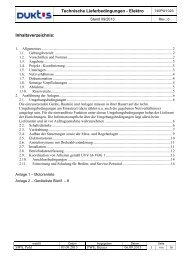Buderus Manual on Trenchless Installation of Ductile Cast ... - Duktus
Buderus Manual on Trenchless Installation of Ductile Cast ... - Duktus
Buderus Manual on Trenchless Installation of Ductile Cast ... - Duktus
Create successful ePaper yourself
Turn your PDF publications into a flip-book with our unique Google optimized e-Paper software.
Inserting the locking segments<br />
DN 00 - DN 1000 BLS ® joints<br />
The joint must not be deflected angularly when the locking segments are being fitted.<br />
First insert the locking segments through the opening in the socket and then distribute<br />
them around the circumference working alternately left and right. Then rotate all the<br />
segments in <strong>on</strong>e directi<strong>on</strong> so that the last segment can be inserted through the opening<br />
in the socket and moved to a positi<strong>on</strong> where the joint is securely locked.<br />
Only a small part <strong>of</strong> the humps <strong>on</strong> the last locking segment must be visible through the<br />
opening in the socket. If any segments happen to jam, they should be moved to their<br />
intended positi<strong>on</strong> by moving the pipe as it hangs from the sling and tapping them gently<br />
with a hammer.<br />
Under no circumstances must the socket or the main body <strong>of</strong> the pipe be hit with the<br />
hammer!<br />
Locking<br />
Pull all the segments back towards the<br />
outside until they butt against the bevel <strong>of</strong><br />
the locking chamber. Then fit the clamping<br />
strap over the segments in the way shown.<br />
Then tighten the clamping strap, but <strong>on</strong>ly<br />
gently so that the segments can still be<br />
moved. Now line the locking segments<br />
up properly. They must lie completely flat<br />
against the body <strong>of</strong> the pipe and they must not overlap. Then tighten the clamping strap<br />
up sufficiently tight for the locking segments to bear firmly against the pipe around the<br />
whole <strong>of</strong> its circumference. It is now no l<strong>on</strong>ger possible for the locking segments to be<br />
moved. Apply axial tracti<strong>on</strong> (e.g. with a locking clamp) and pull the pipe out <strong>of</strong> the joint<br />
until the welding bead comes to rest against the segments.<br />
When the joint is in an undeflected state, the l<strong>on</strong>gitudinal distances from the locking<br />
segments to the end-face <strong>of</strong> the socket should all the approximately the same.<br />
117
















